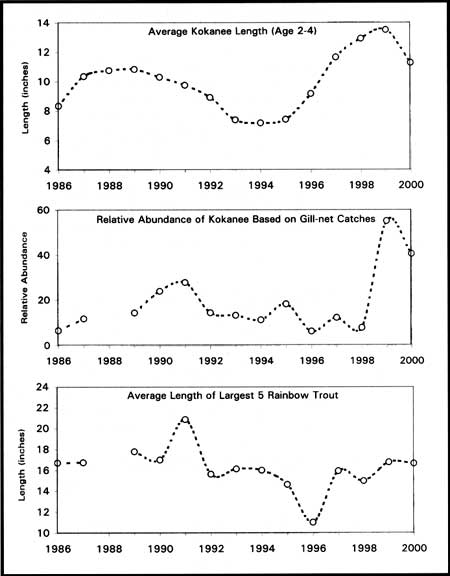With numerous small kokanee salmon present, the summer of 2001 could turn out to be a great time to catch that big rainbow trout in Crater Lake. Although the density of fish in Crater Lake will probably never be high like other more productive lakes of the Pacific Northwest, some days at Crater Lake still promise to be very good fishing. Other days may not be so good, but if you are going to experience a bad day of fishing I cannot think of a better place to go than beautiful Crater Lake.
Note: Fishing access at Crater Lake is fairly limited because of the steep and dangerous caldera walls encircling the lake. A quarter mile section of shoreline is accessible at the base of the Cleetwood Cove Trail for fishing. Anglers can reach Wizard Island in the tour boat operated by the park concessioner, a service allowing passengers to disembark and fish on a day use basis. Devices such as float tubes and rafts are not allowed on the lake due to erratic winds, jagged rocks, and steep shorelines.
Crater Lake National Park’s Long-term Limnological Monitoring Program assesses many chemical and physical aspects of Crater Lake’s ecology. Part of monitoring the fish population involves setting nets to collect fish for analysis. Each fish collected in the nets is measured for length, weight, sex, and maturity level. Scales are collected from each fish to determine fish age. The stomach contents of the fish are preserved for later analysis. The monitoring program also uses a scientific-grade acoustic system (a fancy “fish finder”) to accurately estimate the population size in the lake and assess fish distribution within the water column.
Table 1: Length (inches) of largest fish caught in nets by biologists between 1986 and 2000.
| Kokanee | Rainbow | |||
| Largest fish caught | Average length of largest 5 fish caught |
Largest fish caught | Average length of largest 5 fish caught |
|
| 1986 1987 1988 1989 1990 1991 1992 1993 1994 1995 1996 1997 1998 1999 2000 |
10.5 13.5 15.6 |
9.4 12.3 14.5 |
17.8 18.9 18.9 |
16.7 16.8 17.8 |
Scott Girdner is a fisheries biologist with the National Park Service who has studied Crater Lake since 1995.


